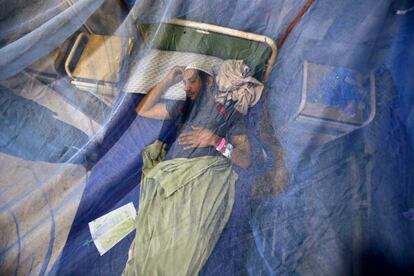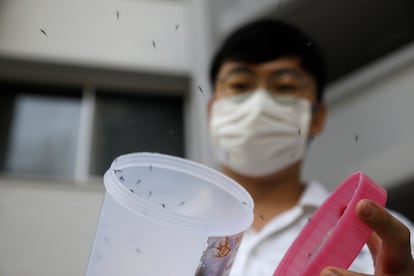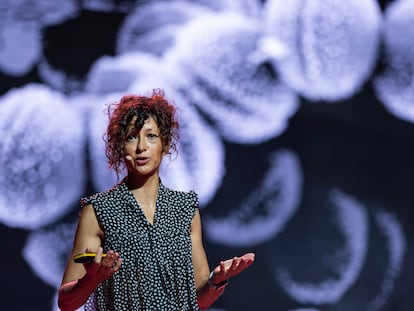Dengue: Colombia lab breeds and releases 40 million bio-modified mosquitos per week
An experiment in Medellín suggests vector control using the mass introduction of a species infected with a parasitic bacteria could be the most promising strategy yet against dengue fever

In Colombia’s second largest city, Medellín, a curious factory produces a curious product. Every week, the facility breeds upwards of 40 million mosquitos, which technicians infect with a parasitic bacteria and then release into the skies of Medellín to fly around, reproduce, and hunt for flesh. What use could such a particular and peculiar industry have? This was the question on Bill Gates’ mind when he visited the lab in August. The answer sounds like the plot of a Hollywood blockbuster: to save millions of lives from the scourge of “breakbone fever,” as dengue is commonly known. In recent years, due to the gradual increase in cases in many parts of the world, the disease has become a primary concern among public health experts. The latest outbreak occurred recently in Pakistan, where floods caused an upsurge in the spread of the virus, and where more than 30,000 people have been infected so far in 2022.

Dengue affects 400 million people annually
Transmitted by Aedes mosquitoes, mainly of the subgenus aegypti, and to a lesser extent albopictus, the virus infects more than 400 million people in more than 100 countries each year, and kills around 20,000 annually, according to the World Health Organization (WHO), although roughly 80% of patients are asymptomatic. When symptoms do arise, they are similar to the flu, and in some serious cases can lead to complications like severe bleeding and organ failure, which can result in death, especially among young children. The seriousness of the disease should not be underestimated: the WHO warns that dengue is already one of the main causes of hospitalization and death among children and adults in the regions where it is most endemic: Asia, Oceania and the Americas. Nevertheless, the agency has set a goal of achieving a zero-case fatality rate by 2030.
Cases are concentrated mainly in urban and peri-urban areas of affected regions, and have increased eightfold since 2000, according to the WHO. After many years of only a handful of cases being reported, a decade ago the virus returned to Europe, where more than 3,000 cases have been reported over the last three years. In 2010, local transmissions were detected for the first time in France and Croatia and since then new infections have been reported every year. This has also been the case in Spain since 2018, the same year that Spanish authorities reported one of the first known cases of sexually transmitted dengue. And to top it all off, arthropod resistance to traditional insecticides is on the rise.
Given growing concern about the increase in infections, Spain’s Royal National Academy of Medicine (RANM) and the Drugs for Neglected Diseases initiative (DNDi) organized a scientific conference on September 28 in Madrid to explore advances in prevention, therapies and vaccines, at a time when there is still no effective treatment for the disease.
Ricardo Molina, head of medical entomology at the Carlos III Health Institute in Madrid, says that dengue has become a “global emergency” as a result not merely of climate change, but of what he calls “global change,” to emphasize the fact that the planet is undergoing a transformation more total and profound than just an altered climate: there are changes to soils, to agricultural systems, and so on. Molina says that these combined factors encourage the spread of the virus. “Globalization is a large part of the problem: maritime and air transport have increased significantly in recent decades and are causing problems with invasive species carrying diseases,” he says. In fact, aedes albopictus, also known as the tiger mosquito and traditionally less common than aegypti, is now the main concern in the European region. “They have a tremendous ability to adapt, which means that they can establish breeding sites in unlikely places, like a glass of water or a car tire. That’s how [dengue] has managed to spread around the world: through the buying and selling of new and used tires originating from endemic regions,” Molina says.
“The tools we have are insufficient,” said Dr. Jorge Alvar, a researcher with RANM, speaking at the September conference in Madrid, which he helped organize. “In terms of therapeutics, there is nothing, and the first vaccine, which was approved for commercial distribution in 2015, has serious limitations. This is why, at present, preventing infection through vector control is the method where we see the most hope. This is the area where the most progress is being made.”
Dr. Alvar then turned the floor over to Professor Iván Darío Vélez, manager of the Colombian branch of the World Mosquito Program (WMP), an international initiative that works to alter Aedes aegypti specimens with the ultimate goal of reducing cases of infectious disease. The results of the study by Vélez’s team in Medellín indicate an 89% drop in infections since the project began in 2015. This is all thanks to the 40 million mosquitoes that Vélez’s team breeds and releases each week, which are modified to carry a naturally occurring bacteria called Wolbachia, which renders them incapable of transmitting the virus.
The Wolbachia bacteria is found in about half of all arthropod species, including fruit flies, moths, dragonflies and butterflies. Its secret is that it can prevent the transmission of the virus that causes dengue, as well as the viruses that cause zika and chikungunya. Wolbachia lives inside cells and passes from one generation to the next through eggs, but it is not naturally present in Aedes, which is why scientists are modifying mosquitoes to host the bacteria. “If a male insect has Wolbachia and mates with a female that does not, the eggs will not hatch. And if the female has it and the male does not, she will lay eggs and they will all hatch, and all her offspring will carry the bacteria. After a few generations, almost all the individuals are carriers and, therefore, do not transmit [the viruses],” Dr. Vélez explained.
Using microscopic needles, the Medellín scientists extracted the bacteria from fruit flies and injected it directly into Aedes aegipti eggs. To do this, they had to build an insectarium. “So, we made a really huge one that many consider to be the most modern facility of its kind in Latin America,” says Vélez. “It really is a factory: we can produce 40 million eggs with Wolbachia per week.” He say that it took his team “thousands and thousands of attempts” before they finally succeeded. Once the mosquitoes were carrying the bacteria, they passed it naturally to their offspring without the need for new injections. Then, these same insects were infected with dengue and, in the doctor’s words, something “really exciting” happened: “The virus did not multiply well in the host and, if the virus can’t multiply, it can’t be transmitted to people.”
The next step was to test the approach in communities that had been plagued by dengue for years. They released specimens with Wolbachia once a week for 20 weeks in Medellín, and within a few months, nearly 100% of the insects were carrying the bacteria. Years later, this is still the case. “The results are clear. Cases have decreased dramatically and we’re hopeful that this method of control can protect the health of nearly 4 billion people in the world who are at risk,” Vélez concluded.
Since 2011, the World Mosquito Program has conducted similar experiments in several countries across Oceania, Europe, Asia and Latin America. The most impressive success story, before the Colombian team presented its findings, was that of Indonesia, where the presence of the virus was reduced by 77% and mortality by 86% in one area in Yogyakarta, the city where the transgenic mosquitoes were released. Globally, the WMP estimates that they have protected ten million people and prevented 300,000 cases and 20,000 hospitalizations in 11 countries: Brazil, Colombia, Mexico, Indonesia, Sri Lanka, Vietnam, Australia, Fiji, Kiribati, New Caledonia and Vanuatu.

Vaccines and drugs in early development
Despite the fact that dengue fever has been around for decades, there is no known effective vaccine or treatment for the disease. The WHO recommends treating symptoms with rest, hydration and medical observation. And, at most, Tylenol, to relieve muscle pain and fever. Isabela Ribeiro, director of the viral diseases group at DNDi, stressed during her speech at the conference in Madrid that efforts should be aimed at seeking treatments that can prevent patients from developing more serious symptoms in order to avoid deaths and prevent the collapse of healthcare systems. Specialized training of doctors can also help, since rapid intervention within the first three or four days after the onset of symptoms is crucial to saving lives. According to Ribeiro’s estimates, between 22% and 53% of patients who arrive at the hospital develop the hemorrhagic version of the disease. “If it is not diagnosed and symptoms are not managed by administering adequate fluids, the disease will evolve into severe dengue, with all its consequences,” Ribeiro said. “When we look at the situation in the Americas, deaths have been decreasing in recent years, mainly because the virus is being detected earlier.”
As for existing vaccine options, there is currently only one, which was developed by the French multinational Sanofi-Pasteur in 2015 and is marketed in 20 countries around the world. But its use is limited by the fact that, when administered to individuals who have never been infected with dengue, it actually increases the risk of developing the more severe version of the disease. Because of this, it is only recommended for people between the ages of 9 and 45 who have had at least one previous instance of infection. Fernando González Romo, a microbiologist at the Carlos III Health Institute, says that there are numerous difficulties facing the development of effective immunization for the four types of dengue that currently exist. “The vaccine will be just one more strategy in a series of strategies that must be developed,” he said.
Tu suscripción se está usando en otro dispositivo
¿Quieres añadir otro usuario a tu suscripción?
Si continúas leyendo en este dispositivo, no se podrá leer en el otro.
FlechaTu suscripción se está usando en otro dispositivo y solo puedes acceder a EL PAÍS desde un dispositivo a la vez.
Si quieres compartir tu cuenta, cambia tu suscripción a la modalidad Premium, así podrás añadir otro usuario. Cada uno accederá con su propia cuenta de email, lo que os permitirá personalizar vuestra experiencia en EL PAÍS.
¿Tienes una suscripción de empresa? Accede aquí para contratar más cuentas.
En el caso de no saber quién está usando tu cuenta, te recomendamos cambiar tu contraseña aquí.
Si decides continuar compartiendo tu cuenta, este mensaje se mostrará en tu dispositivo y en el de la otra persona que está usando tu cuenta de forma indefinida, afectando a tu experiencia de lectura. Puedes consultar aquí los términos y condiciones de la suscripción digital.
More information
Últimas noticias
Most viewed
- Oona Chaplin: ‘I told James Cameron that I was living in a treehouse and starting a permaculture project with a friend’
- Sinaloa Cartel war is taking its toll on Los Chapitos
- Reinhard Genzel, Nobel laureate in physics: ‘One-minute videos will never give you the truth’
- Why the price of coffee has skyrocketed: from Brazilian plantations to specialty coffee houses
- Silver prices are going crazy: This is what’s fueling the rally










































